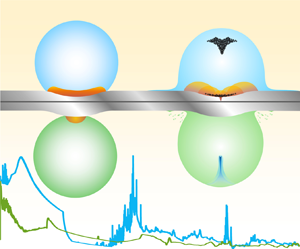Crossref Citations
This article has been cited by the following publications. This list is generated based on data provided by
Crossref.
Biasiori-Poulanges, Luc
and
El-Rabii, Hazem
2021.
Shock-induced cavitation and wavefront analysis inside a water droplet.
Physics of Fluids,
Vol. 33,
Issue. 9,
Guseva, T. S.
2021.
The Initial Stage of Liquid Drop Impingement onto a Curved Surface.
Lobachevskii Journal of Mathematics,
Vol. 42,
Issue. 9,
p.
2144.
Prokhorov, V. E.
2021.
Acoustics of oscillating bubbles when a drop hits the water surface.
Physics of Fluids,
Vol. 33,
Issue. 8,
Cheng, Chuanxiao
Lai, Zhengxiang
Jin, Tingxiang
Jing, Zhiyong
Geng, Wangning
Qi, Tian
Zhu, Shiquan
Zhang, Jun
Liu, Jianxiu
Wang, Fan
Dong, Hongsheng
and
Zhang, Lunxiang
2022.
Rapid nucleation and growth of tetrafluoroethane hydrate in the cyclic process of boiling–condensation.
Energy,
Vol. 256,
Issue. ,
p.
124647.
Wu, Wangxia
Wang, Bing
and
Liu, Qingquan
2022.
Tandem cavity collapse in a high-speed droplet impinging on a constrained wall.
Journal of Fluid Mechanics,
Vol. 932,
Issue. ,
Fujisawa, Kei
2022.
Simulation of lateral jet formation in high-speed liquid droplet impingement and its impact on crater side wall.
Annals of Nuclear Energy,
Vol. 175,
Issue. ,
p.
109202.
Aganin, A. A.
2022.
High-speed Liquid Impact on a Liquid Surface and a Wetted Wall.
Lobachevskii Journal of Mathematics,
Vol. 43,
Issue. 8,
p.
2029.
Gan, Yanbiao
Xu, Aiguo
Lai, Huilin
Li, Wei
Sun, Guanglan
and
Succi, Sauro
2022.
Discrete Boltzmann multi-scale modelling of non-equilibrium multiphase flows.
Journal of Fluid Mechanics,
Vol. 951,
Issue. ,
Rosselló, Juan Manuel
Reese, Hendrik
Raman, K. Ashoke
and
Ohl, Claus-Dieter
2023.
Bubble nucleation and jetting inside a millimetric droplet.
Journal of Fluid Mechanics,
Vol. 968,
Issue. ,
Marzbali, Mason
Yeganehdoust, Firoozeh
Ibrahim, Mohamed
Tarasi, Fariba
and
Jadidi, Mehdi
2023.
Liquid–Solid Impact Mechanism, Liquid Impingement Erosion, and Erosion-Resistant Surface Engineering: A Review.
Coatings,
Vol. 13,
Issue. 3,
p.
577.
Nastic, A.
Vijay, M.
Tieu, A.
and
Jodoin, B.
2023.
High speed water droplet impact erosive behavior on dry and wet pulsed waterjet treated surfaces.
Physics of Fluids,
Vol. 35,
Issue. 5,
Guseva, T. S.
2023.
Analysis of the High-Speed Liquid Impact onto a Curved Liquid Surface with Heymann’s Theory.
Lobachevskii Journal of Mathematics,
Vol. 44,
Issue. 5,
p.
1661.
Xu, Sheng
Fan, Wenqi
Wu, Wangxia
Wen, Haocheng
and
Wang, Bing
2023.
Analysis of wave converging phenomena inside the shocked two-dimensional cylindrical water column.
Journal of Fluid Mechanics,
Vol. 964,
Issue. ,
2023.
A numerical simulation of a droplet impacting a small superhydrophobic cylinder eccentrically.
Physics of Fluids,
Vol. 35,
Issue. 6,
Burson-Thomas, C. B.
Harvey, T. J.
Fletcher, L.
Wellman, R.
Pierron, F.
and
Wood, R. J. K.
2023.
Investigating high-speed liquid impingement with full-field measurements.
Proceedings of the Royal Society A: Mathematical, Physical and Engineering Sciences,
Vol. 479,
Issue. 2277,
Liu, Yanchao
Chu, Xu
Yang, Guang
and
Weigand, Bernhard
2024.
Simulation and analytical modeling of high-speed droplet impact onto a surface.
Physics of Fluids,
Vol. 36,
Issue. 1,
Zhang, Wenbin
Fleischmann, Nico
Adami, Stefan
and
Adams, Nikolaus A.
2024.
A hybrid WENO5IS-THINC reconstruction scheme for compressible multiphase flows.
Journal of Computational Physics,
Vol. 498,
Issue. ,
p.
112672.
Antonov, D.V.
Islamova, A.G.
Orlova, E.G.
and
Strizhak, P.A.
2024.
Droplet collision with hydrophobic and superhydrophobic surfaces: Experimental studies and numerical modeling.
Surfaces and Interfaces,
Vol. 48,
Issue. ,
p.
104264.
Patel, Monal
Viqueira-Moreira, Manuel
Can, Ugur
Hall, Riley
Guven, Ibrahim
and
Brehm, Christoph
2024.
Numerical Modeling of Droplet Impact in High Mach Number Flows with Immersed Boundary Method and Peridynamics.






